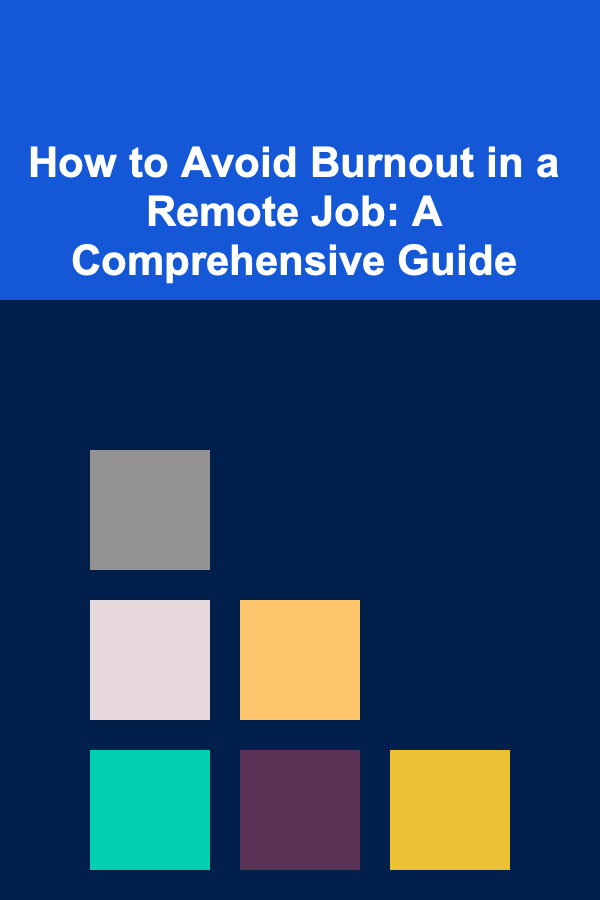
How to Avoid Burnout in a Remote Job: A Comprehensive Guide
ebook include PDF & Audio bundle (Micro Guide)
$12.99$5.99
Limited Time Offer! Order within the next:

The allure of remote work -- the freedom to set your own hours, work from anywhere, and skip the commute -- is undeniable. However, this seemingly idyllic work environment can also be a breeding ground for burnout. The lines between work and life become blurred, the pressure to be constantly available intensifies, and the lack of social interaction can lead to isolation. This comprehensive guide explores the various facets of remote work burnout and provides actionable strategies to prevent it, fostering a sustainable and fulfilling remote career.
Understanding Remote Work Burnout
Burnout is more than just feeling tired. It's a state of emotional, physical, and mental exhaustion caused by prolonged or excessive stress. In the context of remote work, the contributing factors are often amplified.
Key Differences: Remote vs. Traditional Burnout
- Blurred Boundaries: The physical separation between work and home disappears, making it difficult to switch off and recharge. The kitchen table becomes the office, and the laptop perpetually sits within reach.
- Increased Isolation: The lack of spontaneous interactions with colleagues can lead to feelings of loneliness and disconnect. Water cooler conversations are replaced by scheduled Zoom meetings, losing the organic social connection.
- Constant Availability: The expectation to be "always on" is heightened in remote work. The accessibility afforded by technology creates pressure to respond to emails and messages at all hours.
- Overcompensation: Remote workers often feel the need to prove their productivity, leading to overwork and a relentless pursuit of results. This can be driven by a perceived lack of trust or a fear of being seen as less dedicated.
- Lack of Structure: While flexibility is a benefit, the absence of a structured environment can lead to procrastination or, conversely, over-scheduling and inefficient time management.
The Impact of Burnout
Burnout manifests in various ways, impacting both professional and personal life:
- Decreased Productivity: Difficulty concentrating, reduced motivation, and impaired decision-making.
- Increased Errors: Higher likelihood of making mistakes due to fatigue and lack of focus.
- Physical Symptoms: Headaches, stomach problems, sleep disturbances, and weakened immune system.
- Emotional Symptoms: Irritability, anxiety, depression, feelings of hopelessness, and cynicism.
- Relationship Strain: Burnout can negatively impact relationships with family and friends due to increased irritability and emotional withdrawal.
- Reduced Job Satisfaction: Loss of enthusiasm for work, leading to disengagement and a desire to change jobs.
Strategies for Preventing Burnout in a Remote Job
Proactive measures are crucial to mitigate the risk of burnout. The following strategies focus on establishing boundaries, prioritizing well-being, and fostering a sustainable work-life balance.
1. Establish Clear Boundaries Between Work and Life
This is arguably the most critical aspect of preventing remote work burnout. Without physical separation, intentional boundaries are essential.
- Dedicated Workspace: Create a designated workspace that is physically separate from your living area. Even if it's a corner of a room, define it as your "office" and only use it for work-related tasks. When the workday ends, physically leave that space.
- Set a Schedule and Stick to It: Establish a clear start and end time for your workday and adhere to it as closely as possible. Communicate your working hours to colleagues and family members to manage expectations. Use calendar blocking to schedule work tasks, breaks, and personal time.
- "Commute" Simulation: Even without a physical commute, create a transition routine to signal the beginning and end of your workday. This could involve a walk around the block, listening to a podcast, or practicing mindfulness. The act of mentally "commuting" helps to separate work from personal life.
- Disconnect After Work Hours: Turn off work notifications on your phone and computer after your designated work hours. Resist the urge to check emails or respond to messages until the next workday. This allows you to truly disconnect and recharge. Consider using website blockers or app timers to limit access to work-related platforms.
- Communicate Your Boundaries: Clearly communicate your working hours and availability to colleagues, clients, and family members. Set expectations about response times and availability outside of working hours. Don't be afraid to say "no" to requests that fall outside of your established boundaries.
Tip: The "Closing Ritual"
At the end of your workday, create a closing ritual to signal the transition to personal time. This could involve tidying up your workspace, writing down your tasks for the next day, or simply taking a few deep breaths to release the stress of the day.
2. Prioritize Self-Care and Well-being
Taking care of your physical and mental health is paramount to preventing burnout. Neglecting self-care will inevitably lead to exhaustion and decreased productivity.
- Regular Exercise: Physical activity is a powerful stress reliever and mood booster. Aim for at least 30 minutes of moderate-intensity exercise most days of the week. Find activities you enjoy, such as walking, running, swimming, yoga, or dancing.
- Healthy Diet: Nourish your body with a balanced diet that includes plenty of fruits, vegetables, whole grains, and lean protein. Avoid processed foods, sugary drinks, and excessive caffeine, which can contribute to fatigue and anxiety.
- Sufficient Sleep: Prioritize getting 7-9 hours of quality sleep each night. Establish a consistent sleep schedule, create a relaxing bedtime routine, and ensure your bedroom is dark, quiet, and cool.
- Mindfulness and Meditation: Practice mindfulness techniques, such as meditation, deep breathing exercises, or yoga, to reduce stress and improve focus. Even a few minutes of mindfulness each day can make a significant difference.
- Take Breaks Throughout the Day: Avoid working for extended periods without taking breaks. Get up and move around, stretch, or step away from your computer to clear your head. Use the Pomodoro Technique (working in focused bursts with short breaks) to improve productivity and prevent mental fatigue.
- Engage in Hobbies and Interests: Make time for activities you enjoy outside of work. This could include reading, painting, gardening, playing music, or spending time with loved ones. Engaging in hobbies helps you to disconnect from work and recharge your batteries.
- Social Connection: Combat isolation by staying connected with friends, family, and colleagues. Schedule regular video calls, join online communities, or participate in social activities outside of work. Even a brief conversation with a loved one can boost your mood and reduce feelings of loneliness.
Tip: Schedule "Me Time"
Treat your self-care activities as important appointments and schedule them into your calendar. This will help you prioritize your well-being and prevent you from neglecting it in favor of work. Don't feel guilty about taking time for yourself; it's essential for maintaining your health and productivity.
3. Optimize Your Work Environment
A comfortable and productive workspace can significantly reduce stress and improve your overall well-being.
- Ergonomic Setup: Invest in an ergonomic chair, desk, and monitor to ensure proper posture and reduce strain on your body. Adjust your monitor height so that the top of the screen is at or slightly below eye level. Use a keyboard and mouse that are comfortable for your hands and wrists.
- Good Lighting: Ensure your workspace is well-lit with natural light or full-spectrum artificial light. Avoid harsh fluorescent lighting, which can cause eye strain and headaches.
- Minimize Distractions: Create a quiet and distraction-free workspace. Turn off notifications on your phone and computer, use noise-canceling headphones, or play calming music. Communicate with family members or housemates about your need for uninterrupted work time.
- Personalize Your Space: Add personal touches to your workspace to make it more comfortable and inviting. This could include plants, photos, artwork, or anything that brings you joy.
- Maintain a Clean and Organized Workspace: A cluttered workspace can contribute to stress and anxiety. Take a few minutes each day to tidy up your desk and organize your materials.
- Invest in Reliable Technology: Ensure you have a stable internet connection and reliable hardware and software. Technical difficulties can be a major source of frustration and stress in remote work.
Tip: The Pomodoro Technique for Breaks
Implement the Pomodoro Technique: work for 25 minutes followed by a 5-minute break. After four "pomodoros," take a longer break of 15-20 minutes. This structured approach helps to maintain focus and prevent mental fatigue.
4. Improve Time Management and Prioritization Skills
Effective time management and prioritization are crucial for managing workload and reducing stress in a remote work environment.
- Prioritize Tasks: Use a prioritization matrix (e.g., Eisenhower Matrix) to identify and focus on the most important tasks. Prioritize tasks based on urgency and importance, and delegate or eliminate less critical tasks.
- Break Down Large Tasks: Divide large, overwhelming tasks into smaller, more manageable steps. This makes the task less daunting and easier to complete.
- Use Time Management Techniques: Experiment with different time management techniques, such as time blocking, the Pomodoro Technique, or the Getting Things Done (GTD) method, to find what works best for you.
- Learn to Say No: Don't be afraid to say "no" to additional tasks or requests that will overload your schedule or compromise your well-being. Politely decline requests that are not essential or that you don't have the capacity to handle.
- Batch Similar Tasks: Group similar tasks together and complete them in a single block of time. This reduces context switching and improves efficiency. For example, respond to all emails at once, rather than checking them sporadically throughout the day.
- Delegate When Possible: If possible, delegate tasks to other team members or outsource them to freelancers. Delegation frees up your time and allows you to focus on higher-priority activities.
Tip: The Eisenhower Matrix
The Eisenhower Matrix categorizes tasks into four quadrants: Urgent and Important, Important but Not Urgent, Urgent but Not Important, and Neither Urgent Nor Important. Focus on tasks in the Urgent and Important quadrant, schedule tasks in the Important but Not Urgent quadrant, delegate tasks in the Urgent but Not Important quadrant, and eliminate tasks in the Neither Urgent Nor Important quadrant.
5. Foster Strong Communication and Collaboration
Effective communication and collaboration are essential for maintaining team cohesion and preventing feelings of isolation in remote work.
- Regular Check-ins: Schedule regular check-ins with your manager and team members to discuss progress, address challenges, and provide support. Use video conferencing to foster a sense of connection and build relationships.
- Utilize Communication Tools: Use communication tools, such as Slack, Microsoft Teams, or email, to stay connected with colleagues and clients. Establish clear communication protocols to ensure efficient and effective communication.
- Proactive Communication: Communicate proactively with your team members about your progress, challenges, and availability. Don't wait for others to reach out to you; take the initiative to keep them informed.
- Virtual Social Events: Organize virtual social events, such as virtual coffee breaks, happy hours, or team-building activities, to foster a sense of community and camaraderie.
- Active Listening: Practice active listening during virtual meetings and conversations. Pay attention to what others are saying, ask clarifying questions, and provide thoughtful feedback.
- Provide and Seek Feedback: Regularly provide and seek feedback from your manager and team members to improve your performance and communication skills. Constructive feedback can help you identify areas for improvement and address potential issues before they escalate.
Tip: Schedule "Water Cooler" Time
Dedicate a few minutes each day to informal conversations with colleagues. These casual interactions can help to foster relationships, build rapport, and prevent feelings of isolation. Use video conferencing to make these conversations more engaging and personal.
6. Seek Support and Resources
Don't hesitate to seek support from your employer, colleagues, or mental health professionals if you're struggling with burnout.
- Talk to Your Manager: Communicate your concerns to your manager and discuss potential solutions. They may be able to provide support, adjust your workload, or offer resources to help you manage stress.
- Connect with Colleagues: Reach out to your colleagues for support and advice. They may have experienced similar challenges and can offer valuable insights and perspectives.
- Utilize Employee Assistance Programs (EAPs): Many employers offer EAPs that provide confidential counseling and support services to employees. Take advantage of these resources if you're struggling with burnout or other mental health concerns.
- Consider Therapy or Counseling: If you're experiencing persistent symptoms of burnout, consider seeking professional help from a therapist or counselor. They can provide you with tools and strategies to manage stress, improve your mental health, and prevent burnout.
- Join Online Communities: Connect with other remote workers in online communities or forums. Sharing your experiences and connecting with others who understand the challenges of remote work can be incredibly helpful.
Tip: Be Honest With Yourself
Acknowledge your feelings and be honest with yourself about your level of stress and exhaustion. Ignoring the warning signs of burnout will only make the problem worse. Take proactive steps to address your concerns and prioritize your well-being.
Long-Term Sustainability: Building a Resilient Remote Work Lifestyle
Preventing burnout is not a one-time fix; it's an ongoing process of building a sustainable and resilient remote work lifestyle.
- Regularly Evaluate Your Boundaries: Periodically review your work-life boundaries and make adjustments as needed. Your needs and priorities may change over time, so it's important to adapt your boundaries accordingly.
- Continuously Improve Your Time Management Skills: Stay up-to-date on the latest time management techniques and strategies. Experiment with different approaches to find what works best for you.
- Invest in Your Professional Development: Continue to learn and grow in your field. This can help you stay engaged and motivated in your work.
- Seek Out New Challenges: Look for opportunities to take on new challenges and expand your skill set. This can help you to avoid boredom and stagnation.
- Celebrate Your Accomplishments: Acknowledge and celebrate your achievements, both big and small. This can help you to maintain a positive attitude and stay motivated.
- Practice Gratitude: Take time each day to appreciate the positive aspects of your life and work. This can help you to reduce stress and improve your overall well-being.
- Remember Your "Why": Reconnect with the reasons why you chose remote work in the first place. This can provide a renewed sense of purpose and motivation. Remind yourself of the flexibility, autonomy, and other benefits that remote work offers.
Conclusion
Remote work offers numerous advantages, but it also presents unique challenges that can contribute to burnout. By understanding the risk factors, establishing clear boundaries, prioritizing self-care, optimizing your work environment, improving your time management skills, fostering strong communication, and seeking support when needed, you can create a sustainable and fulfilling remote career. Remember that preventing burnout is an ongoing process, and it requires a commitment to prioritizing your well-being and building a resilient remote work lifestyle. Embrace the flexibility and freedom of remote work, but do so with intention and awareness, ensuring that you're thriving, not just surviving.

How to Budget for Your Home Office Setup
Read More
How to Create a Checklist for Reviewing and Updating Your Child's Study Habits
Read More
How to Use Scrapbooking Techniques for Time Capsule Organization
Read More
How To Master Financial Forecasting for Small Businesses
Read More
Mastering the Springform Pan: Baking Cheesecakes and Delicate Desserts
Read More
How To Be Your Most Beautiful Self Inside and Out
Read MoreOther Products

How to Budget for Your Home Office Setup
Read More
How to Create a Checklist for Reviewing and Updating Your Child's Study Habits
Read More
How to Use Scrapbooking Techniques for Time Capsule Organization
Read More
How To Master Financial Forecasting for Small Businesses
Read More
Mastering the Springform Pan: Baking Cheesecakes and Delicate Desserts
Read More